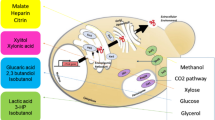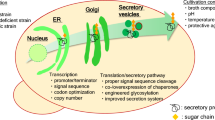Abstract
Limited proteolysis of intact yeast methionine aminopeptidase (MAP1) with trypsin releases a 34 kDa fragment whose NH2-terminal sequence begins at Asp70, immediately following Lys69. These results suggest that yeast MAP may have a two-domain structure consisting of an NH2-terminal zinc finger domain and a C-terminal catalytic domain. To test this, a mutant MAP lacking residues 2–69 was generated, overexpressed, purified and analyzed. Metal ion analyses indicate that 1 mol of wild-type yeast MAP contains 2 mol of zinc ions and at least 1 mol of cobalt ion, whereas 1 mol of the truncated MAP lacking the putative zinc fingers contains only a trace amount of zinc ions but still contains one mole of cobalt ion. These results suggest that the two zinc ions observed in the native yeast MAP are located at the Cys/His rich region and the cobalt ion is located in the catalytic domain. The k.at and Km values of the purified truncated MAP are similar to those of the wild-type MAP when measured with peptide substrates in vitro and it appears to be as active as the wild-type MAP in vivo. However, the truncated MAP is significantly less effective in rescuing the slow growth phenotype of map mutant than the wild-type MAP. These findings suggest that the zinc fingers are essential for normal MAP function in vivo, even though the in vitro enzyme assays indicate that they are not involved in catalysis. In addition, a series of single mutations were generated by changing the cysteines and the histidines in the zinc finger region to serines and arginines, respectively. Analyses of these point mutations provide further evidence that the cysteines and histidines are important for the growth promotion function of yeast MAP.
Similar content being viewed by others
References
Adams JM (1968) On the release of the formyl group from nascent protein. J Mol Biol 33:571–589
Bachmair A, Finley D, Varshavsky A (1986) In vivo half-life of a protein is a function of its amino-terminal residue. Science 234:179–186
Ball LA, Kaesberg P (1973) Cleavage of the N-terminal formylmethionine residue from a bacteriophage coat protein in vitro. J Mol Biol 79:531–537
Ben-Bassat A, Bauer K, Chang SY, Myambo K, Boosman A, Chang S (1987) Processing of the initiation methionine from proteins: properties of the Escherichia coli methionine aminopeptidase and its gene structure. J Bacteriol 169:751–757
Berg JM (1988) Proposed structure for the zinc-binding domains from transcription factor IIIa and related proteins. Proc Nall Acad Sci U S A 85:99–102
Bradford MM (1976) A rapid and sensitive method for the quantitation of microgram quantities of protein utilizing the principle of protein-dye binding. Anal Biochem 72:248–254
Buss JE, Sefton BM (1986) Direct identification of palmitic acid as the lipid attached to p21ras. Mol Cell Biol 6:116–122
Carr SA, Biemann K, Shoji S, Parmelee DC, Titani K (1982) n-Tetradecanoyl is the NH2-terminal blocking group of the catalytic subunit of cyclic AMP-dependent protein kinase from bovine cardiac muscle. Proc Natl Acad Sci USA 79:6128–131
Chang YH, Smith JA (1989) Molecular cloning and sequencing of genomic DNA encoding aminopeptidase I from Saccharomyces cerevisiae. J Biol Chem 264:6979–6983
Chang YH, Teichert U, Smith JA (1990) Purification and characterization of a methionine aminopeptidase from Saccharomyces cerevisiae. J Biol Chem 265:19892–19897
Chang YH, Teichert U, Smith JA (1992) Molecular cloning, sequencing, deletion, and overexpression of a methionine aminopeptidase gene from Saccharomyces cerevisiae. J Biol Chem 267:8007–11
Cheung AK (1991) Cloning of the latency gene and the early protein 0 gene of pseudorabies virus. J Virol 65:5260–5271
Cohen SA, Michaud DP (1993) Synthesis of a fluorescent derivatizing reagent, 6-aminoquinolyl-N-hydroxysuccinimidyl carbamate, and its application for analysis of hydrolysate amino acids via High-Performance Liquid Chromatography. Anal Biochem 211:279–287
Cyert MS, Thorner J (1992) Regulatory subunit (CNB1 gene product) of yeast Ca2+/calmodulin-dependent phosphoprotein phosphatases is required for adaptation to pheromone. Mol Cell Biol 12:3460–3469
Davison AJ, Scott JE (1986) The complete DNA sequence of varicella-zoster virus. J Gen Virol 67:1759–816
Duronio RJ, Towler DA, Heuckeroth RO, Gordon JI (1989) Disruption of the yeast N-myristoyl transferase gene causes recessive lethality. Science 243:796–800
Freemont PS, Hanson IM, Trowsdale J (1991) A novel cysteinerich sequence motif. Cell 64:483–484
Gibson TJ, Postma JP, Brown RS, Argos P (1988) A model for the tertiary structure of the 28 residue DNA-binding motif (‘zinc finger’) common to many eukaryotic transcriptional regulatory proteins. Protein Engi 2:209–218
Gordon JI, Duronio RJ, Rudnick DA, Adams SP, Gokel GW (1991) Protein N-myristoylation. J Biol Chem 266:8647–8650
Harlow E, Lane D (1988) Antibodies: a Laboratory Manual. Cold Spring Harbor Laboratory Press, Cold Spring Harbor, New York
Hewick RM, Hunkapiller MW, Hood LE, Dreyer WJ (1981) A gas-liquid solid phase peptide and protein sequenator. J Biol Chem 256:7990–7997
Ho IC, Vorhees P, Marin N, Oakley BK, Tsai SF, Orkin SH, Leiden JM (1991) Human GATA-3: a lineage-restricted transcription factor that regulates the expression of the T cell receptor alpha gene. EMBO J 10:1187–1192
Hohfeld J, Mertens D, Wiebel FF, Kunau WH (1992) Defining components required for peroxisome assembly in Saccharomyces cerevisiae. In: Neupert W, Lill R (eds) Membrane biogenesis and protein targeting. Elsevier, Amsterdam, pp 185–207
Housman D, Gillespie D, Lodish HF (1972) Removal of formylmethionine residue from nascent bacteriophage f2 protein. J Mol Biol 65:163–166
Huang S, Elliott RC, Liu PS, Koduri RK, Weickmann JL, Lee JH, Blair LC, Ghosh-Dastidar P, Bradshaw RA, Bryan KM, et al. (1987) Specificity of cotranslational amino-terminal processing of proteins in yeast. Biochemistry 26:8242–8246
Ito H, Fukuda Y, Murata K, Kimura A (1983) Transformation of intact yeast cells treated with alkali cations. J Bacteriol 153:163–168
James G, Olson EN (1990) Fatty acylated proteins as components of intracellular signaling pathways. Biochemistry 29:2623–2634
Jones JS, Weber S, Prakash L (1988) The Saccharomyces cerevisiae RAD18 gene encodes a protein that contains potential zinc finger domains for nucleic acid binding and a putative nucleotide binding sequence. Nucleic Acids Res 16:7119–7131
Kendall RL, Bradshaw RA (1992) Isolation and characterization of the methionine aminopeptidase from porcine liver responsible for the co-translational processing of proteins. J Biol Chem 267:20667–20673
Kim JG, Hudson LD (1992) Novel member of the zinc finger superfamily: A C2-HC finger that recognizes a glia-specific gene. Mol Cell Biol 12:5632–5639
Kunkel TA (1985) Rapid and efficient site-specific mutagenesis without phenotypic selection. Proc Nat] Acad Sci USA 82:488–492
Kunkel TA, Roberts JD, Zakour RA (1987) Rapid and efficient site-specific mutagenesis without phenotypic selection. Methods Enzymol 154:367–382
Laemmli UK (1970) Cleavage of structural proteins during the assembly of the head of bacteriophage T4. Nature 227:680–685
Lee FJ, Lin LW, Smith JA (1989) Nα-acetylation is required for normal growth and mating of Saccharomyces cerevisiae. J Bacteriol 171:5795–5802
Lovering R, Hanson IM, Borden KL, Martin S, O'Reilly NJ, Evan GI, Rahman D, Pappin DJ, Trowsdale J, Freemont PS (1993) Identification and preliminary characterization of a protein motif related to the zinc finger. Proc Natl Acad Sci USA 90:2112–2116
Miller CG, Strauch KL, Kukral AM, Miller JL, Wingfield PT, Mazzei GJ, Werlen RC, Graber P, Movva NR (1987) N-terminal methionine-specific peptidase in Salmonella typhimurium. Proc Natl Acad Sci USA 84:2718–2722
Moerschell RP, Hosokawa Y, Tsunasawa S, Sherman F (1990) The specificities of yeast methionine aminopeptidase and acetylation of amino-terminal methionine in vivo. Processing of altered iso-1-cytochromes c created by oligonucleotide transformation. J Biol Chem 265:19638–19643
Pan T, Coleman JE (1991) Sequential assignments of the 1H NMR resonances of Zn(II)2 and 113Cd(II)2 derivatives of the DNAbinding domain of the GAL4 transcription factor reveal a novel structural motif for specific DNA recognition. Biochemistry 30:4212–4222
Prchal JT, Cashman DP, Kan YW (1986) Hemoglobin Long Island is caused by a single mutation (adenine to cytosine) resulting in a failure to cleave amino-terminal methionine. Proc Natl Acad Sci USA 83:24–27
Roderick SL, Matthews BW (1993) Structure of the cobalt-dependent methionine aminopeptidase from Escherichia coli: a new type of proteolytic enzyme. Biochemistry 32:3907–3912
Sanger F, Nicklen S, Coulson AR (1977) DNA sequencing with chain-terminating inhibitors. Proc Natl Acad Sci USA 74:5463–5467
Schrock III RD, Lloyd RS (1993) Site-directed mutagenesis of the NH2 terminus of T4 endonuclease V. The position of the alpha NH2 moiety affects catalytic activity. J Biol Chem 268:880–886
Schwabe JW, Rhodes D (1991) Beyond zinc fingers: steroid hormone receptors have a novel structural motif for DNA recognition. Trends in Biochemical Sci 16:291–296
Stearns T, Kahn RA, Botstein D, Hoyt MA (1990a) ADP ribosylation factor is an essential protein in Saccharomyces cerevisiae and is encoded by two genes. Mol Cell Biol 10:6690–6699
Stearns T, Willingham MC, Botstein D, Kahn RA (1990b) ADP-ribosylation factor is functionally and physically associated with the Golgi complex. Proc Natl Acad Sci USA 87:1238–1242
Studier FW, Rosenberg AH, Dunn JJ, Dubendorff JW (1990) Use of T7 RNA polymerase to direct expression of cloned genes. Methods Enzymol 185:60–89
Takeda M, Webster RE (1968) Protein chain initiation and deformylation in B. subtilis homogenates. Proc Natl Acad Sci USA 60:1487–1494
Tsunasawa S, Stewart JW, Sherman F (1985) Amino-terminal processing of mutant forms of yeast iso-1-cytochrome c. The specificities of methionine aminopeptidase and acetyltransferase. J Biol Chem 260:5382–5391
Walker JP (1963) The NH2-terminal residues of the proteins from cell-free extract of E. coli. J Mol Biol 7:483–496
Wilcox C, Hu JS, Olson EN (1987) Acylation of proteins with myristic acid occurs cotranslationally. Science 238:1275–1278
Yamamoto M, Ko LJ, Leonard MW, Beug H, Orkin SH, Engel JD (1990) Activity and tissue-specific expression of the transcription factor NF-E1 multigene family. Genes Dev 4:1650–1662
Author information
Authors and Affiliations
Additional information
Communicated by C. Hollenberg
Rights and permissions
About this article
Cite this article
Zuo, S., Guo, Q., Ling, C. et al. Evidence that two zinc fingers in the methionine aminopeptidase from Saccharomyces cerevisiae are important for normal growth. Molec. Gen. Genet. 246, 247–253 (1995). https://doi.org/10.1007/BF00294688
Received:
Accepted:
Issue Date:
DOI: https://doi.org/10.1007/BF00294688




